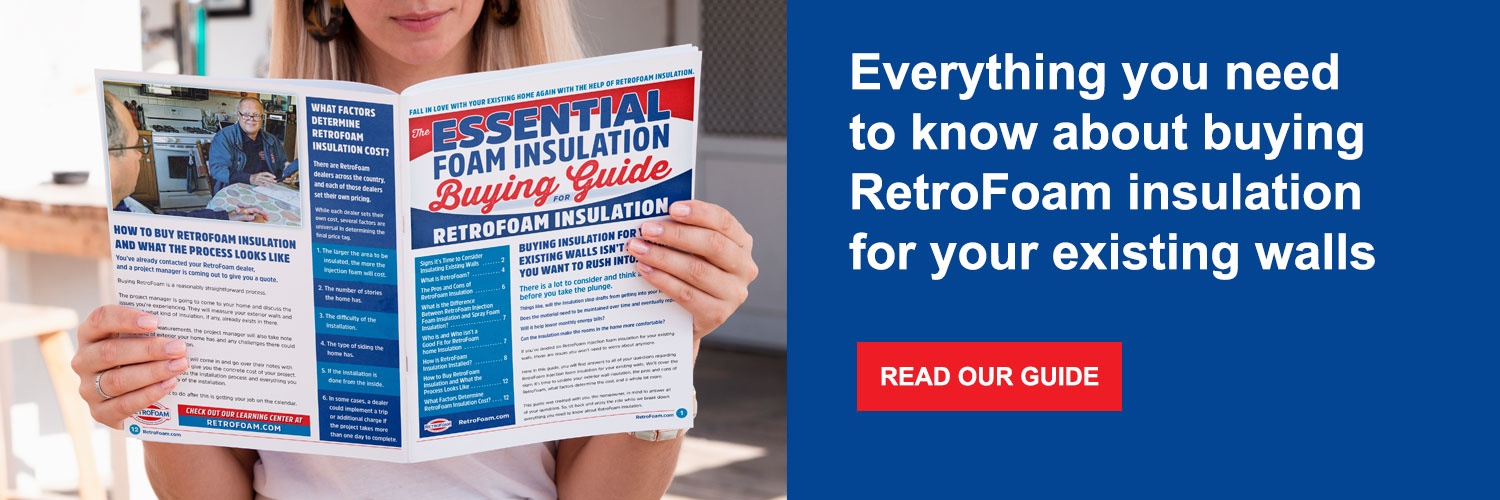How Much Can RetroFoam Insulation Help Me Save on Energy Bills?
spray foam insulation | RetroFoam insulation | FAQs | energy efficiency


How Much Money Can RetroFoam Save on Energy Bills? (Quick Answer)
The amount of money you can save on monthly energy bills can vary depending on your home’s age, construction, and your lifestyle. Your thermostat settings and electrical usage also play a role. Depending on these factors, you could save money on your energy bills between 15 to 50 percent.
Let’s get more into how RetroFoam injection foam insulation helps with utility costs.
Your monthly energy bills are eating up all the extra cash in your wallet, and you’ve heard RetroFoam insulation can help.
Energy savings with foam insulation is a real thing, but the amount you can save will vary. We’ll get more into that in just a minute.
RetroFoam dealers across the country have helped thousands of homeowners save money on their monthly heating and cooling costs. They can do this because RetroFoam creates an air seal that prevents air movement through exterior walls.
Reducing air leakage by creating an air seal is just one way the U.S. Department of Energy recommends lowering monthly energy bills. In comparison to traditional insulation, foam is the only material that can create that air seal.
Does Spray Foam Insulation Save Money on Heating and Cooling Costs?
Spray foam insulation energy savings is definitely a thing.
While RetroFoam is an injection foam, it is often referred to as spray foam. No matter what you call it, both injection foam and spray foam insulation create an air seal. That air seal prevents your furnace and air conditioner from constantly running to keep your home warm in the winter and cool in the summer.
Let’s talk a little more about that usage because that is a massive factor in savings.
In 2015, the U.S. Energy Information Administration found that 51 percent of a household’s energy usage was for space heating and air conditioning. Now imagine if either of these appliances is constantly running because your home is uncomfortable. Your usage would go through the roof, and so would your monthly bills.
When your home can’t maintain a constant temperature and is uncomfortable year-round, all of the air you pay to treat is leaking outside, and that outside air is getting inside. This is where energy savings spray foam insulation can help with the air seal.
Your treated air stays inside where you want it while keeping the elements out. Now your AC unit and furnace don’t have to pull double duty.
How Much Money Does Spray Foam Insulation Save on Energy Bills?
The amount of money you save on monthly energy bills will vary, and there are a few factors that determine the final amount.
Insulating your existing walls with RetroFoam insulation can save you up to 50 percent depending on those other factors.
Another thing to consider is the money you’ll save because you don’t have to update or replace the injection foam.
Fiberglass and cellulose are known to sag, shift, and settle over time, which means they have to be regularly maintained and eventually replaced. That is an added cost every few years on top of the outrageous energy bills.
Foam insulation never breaks down, it never shifts or sags, and it will never have to be replaced because it’s old. When compared to traditional insulation, this will save you money over time because there is no replacement or maintenance cost.
Factors that Determine Foam Insulation Energy Savings
Homeowners could save up to 50 percent on monthly energy bills, but what have they done to hit that mark or higher?
Several things come into play when talking about energy savings. Here is how your HVAC system, AC unit and furnace, doors and windows, and foam insulation play a role.
Your Home's HVAC System and Ducts
If the ducts in your home haven’t been cleaned in a while, it probably costs you money.
Your HVAC system needs to run smoothly and cleanly if you want an energy-efficient home.
You’ll want to make sure you have your AC unit and furnace serviced each year, and as a part of that comes some cleaning. You’ll want to clean the appliances themselves, but you’ll also want to put in clean filters and have the ducts cleaned.
Making sure this annual maintenance is done will make those mechanicals run more efficiently, and that efficiency will save you some dough.
Air Conditioner Unit and Furnace Usage
Do you set your furnace really high in the winter and your air conditioner really low in the summer?
The usage of these two appliances can significantly impact your monthly energy costs.
If you’re having trouble keeping your house the temperature you want it, stopping the air leaks through the walls can help. That is a benefit of RetroFoam is that it will keep that air you’re heating or cooling where you want it and your home at the temperature you want it.
There are also some tips from the Department of Energy that can also help keep those mechanicals from overworking.
Turning the thermostat back 7 to 10 degrees for 8 hours a day can save you about 10 percent on heating and cooling costs. You can set that temperature for the times you’re at work or when you’re asleep.
In the winter, you could set your thermostat at 68 degrees, and in the summer, set it at 78 degrees.
Running either appliance full blast to try and cool off or heat up your home won’t work as you want it to. It won’t make it more comfortable faster -- it will just cost you more money.
Leaky Doors and Windows
You can create an air seal in your home, but if your windows and doors are leaking like a sieve, you’re still losing money.
In the winter, you can feel the cold air coming in around the windows and doors. In the summer, the hot air is also seeping in. With this air leakage, you’re forced to try and keep your home comfortable to no avail.
Sealing around those leaky doors and windows will help reduce the amount you need to use your AC unit or furnace. You might also choose to replace them with more energy-efficient options.
Areas of the Home Insulated with Foam
Sealing the entire building envelope of your home is ideal.
Sure, RetroFoam dealers can inject foam into your walls, but what about the rest of your home?
If you seal up your walls with foam but don’t do anything with your attic, you won’t save as much money as you possibly could.
Well, you’re in luck. Some RetroFoam dealers also offer spray foam insulation or another material that can help you stop or manage those other air leaks.
Save Money on Your Energy Bills with RetroFoam
As you can see, insulating your existing walls with RetroFoam injection foam insulation can reduce your monthly energy bills and give your mechanicals a much-needed break.
If you’re looking to take steps to make your home more energy-efficient while also making it more comfortable, check out the Dealer Finder on our website to find a RetroFoam dealer near you. They will be able to help you with solutions to your energy efficiency problems.
Related Articles
Essential Tips for Buying RetroFoam Insulation
Insulating One Problem Wall with RetroFoam: Will it Make a Difference?
Ten Home Problems That May Warrant Adding RetroFoam Insulation to Exterior Walls
About Amanda Emery
Amanda previously has worked as a breaking news and crime reporter, TV news producer, and editor. As a journalist, she has won several awards from The Society of Professional Journalists - Detroit Chapter and the Michigan Press Association. Amanda uses her experience as a journalist to write content that will help educate homeowners on foam insulation benefits. When Amanda isn’t writing, she’s spending time with her husband Chris, daughter Lilith-Maeve, and rescued huskies Danger and Wendigo. She also loves knitting, making art, and cooking.


